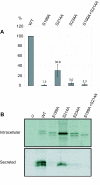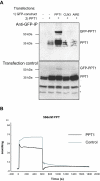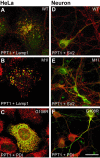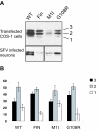Glycosylation, transport, and complex formation of palmitoyl protein thioesterase 1 (PPT1)--distinct characteristics in neurons
- PMID: 17565660
- PMCID: PMC1906764
- DOI: 10.1186/1471-2121-8-22
Glycosylation, transport, and complex formation of palmitoyl protein thioesterase 1 (PPT1)--distinct characteristics in neurons
Abstract
Background: Neuronal ceroid lipofuscinoses (NCLs) are collectively the most common type of recessively inherited childhood encephalopathies. The most severe form of NCL, infantile neuronal ceroid lipofuscinosis (INCL), is caused by mutations in the CLN1 gene, resulting in a deficiency of the lysosomal enzyme, palmitoyl protein thioesterase 1 (PPT1). The deficiency of PPT1 causes a specific death of neocortical neurons by a mechanism, which is currently unclear. To understand the function of PPT1 in more detail, we have further analyzed the basic properties of the protein, especially focusing on possible differences in non-neuronal and neuronal cells.
Results: Our study shows that the N-glycosylation of N197 and N232, but not N212, is essential for PPT1's activity and intracellular transport. Deglycosylation of overexpressed PPT1 produced in neurons and fibroblasts demonstrates differentially modified PPT1 in different cell types. Furthermore, antibody internalization assays showed differences in PPT1 transport when compared with a thoroughly characterized lysosomal enzyme aspartylglucosaminidase (AGA), an important observation potentially influencing therapeutic strategies. PPT1 was also demonstrated to form oligomers by size-exclusion chromatography and co-immunoprecipitation assays. Finally, the consequences of disease mutations were analyzed in the perspective of our new results, suggesting that the mutations increase both the degree of glycosylation of PPT1 and its ability to form complexes.
Conclusion: Our current study describes novel properties for PPT1. We observe differences in PPT1 processing and trafficking in neuronal and non-neuronal cells, and describe for the first time the ability of PPT1 to form complexes. Understanding the basic characteristics of PPT1 is fundamental in order to clarify the molecular pathogenesis behind neurodegeneration in INCL.
Figures









Similar articles
-
Cln3-mutations underlying juvenile neuronal ceroid lipofuscinosis cause significantly reduced levels of Palmitoyl-protein thioesterases-1 (Ppt1)-protein and Ppt1-enzyme activity in the lysosome.J Inherit Metab Dis. 2019 Sep;42(5):944-954. doi: 10.1002/jimd.12106. Epub 2019 May 14. J Inherit Metab Dis. 2019. PMID: 31025705 Free PMC article.
-
Ppt1-deficiency dysregulates lysosomal Ca++ homeostasis contributing to pathogenesis in a mouse model of CLN1 disease.J Inherit Metab Dis. 2022 May;45(3):635-656. doi: 10.1002/jimd.12485. Epub 2022 Mar 17. J Inherit Metab Dis. 2022. PMID: 35150145 Free PMC article.
-
An over-expression system for characterizing Ppt1 function in Drosophila.BMC Neurosci. 2003 Nov 20;4:30. doi: 10.1186/1471-2202-4-30. BMC Neurosci. 2003. PMID: 14629778 Free PMC article.
-
Pathogenesis and therapies for infantile neuronal ceroid lipofuscinosis (infantile CLN1 disease).Biochim Biophys Acta. 2013 Nov;1832(11):1906-9. doi: 10.1016/j.bbadis.2013.05.026. Epub 2013 Jun 6. Biochim Biophys Acta. 2013. PMID: 23747979 Free PMC article. Review.
-
Developmental changes in the expression of neuronal ceroid lipofuscinoses-linked proteins.Mol Genet Metab. 2000 Sep-Oct;71(1-2):190-4. doi: 10.1006/mgme.2000.3071. Mol Genet Metab. 2000. PMID: 11001810 Review.
Cited by
-
Complex Structural PPT1 Variant Associated with Non-syndromic Canine Retinal Degeneration.G3 (Bethesda). 2019 Feb 7;9(2):425-437. doi: 10.1534/g3.118.200859. G3 (Bethesda). 2019. PMID: 30541930 Free PMC article.
-
Identification of substrates of palmitoyl protein thioesterase 1 highlights roles of depalmitoylation in disulfide bond formation and synaptic function.PLoS Biol. 2022 Mar 31;20(3):e3001590. doi: 10.1371/journal.pbio.3001590. eCollection 2022 Mar. PLoS Biol. 2022. PMID: 35358180 Free PMC article.
-
Loss of Depalmitoylation Disrupts Homeostatic Plasticity of AMPARs in a Mouse Model of Infantile Neuronal Ceroid Lipofuscinosis.J Neurosci. 2023 Dec 6;43(49):8317-8335. doi: 10.1523/JNEUROSCI.1113-23.2023. J Neurosci. 2023. PMID: 37884348 Free PMC article.
-
Quantitative analysis of PPT1 interactome in human neuroblastoma cells.Data Brief. 2015 Jun 12;4:207-16. doi: 10.1016/j.dib.2015.05.016. eCollection 2015 Sep. Data Brief. 2015. PMID: 26217791 Free PMC article.
-
Novel interactions of CLN5 support molecular networking between Neuronal Ceroid Lipofuscinosis proteins.BMC Cell Biol. 2009 Nov 26;10:83. doi: 10.1186/1471-2121-10-83. BMC Cell Biol. 2009. PMID: 19941651 Free PMC article.
References
Publication types
MeSH terms
Substances
LinkOut - more resources
Full Text Sources
Molecular Biology Databases
Miscellaneous

